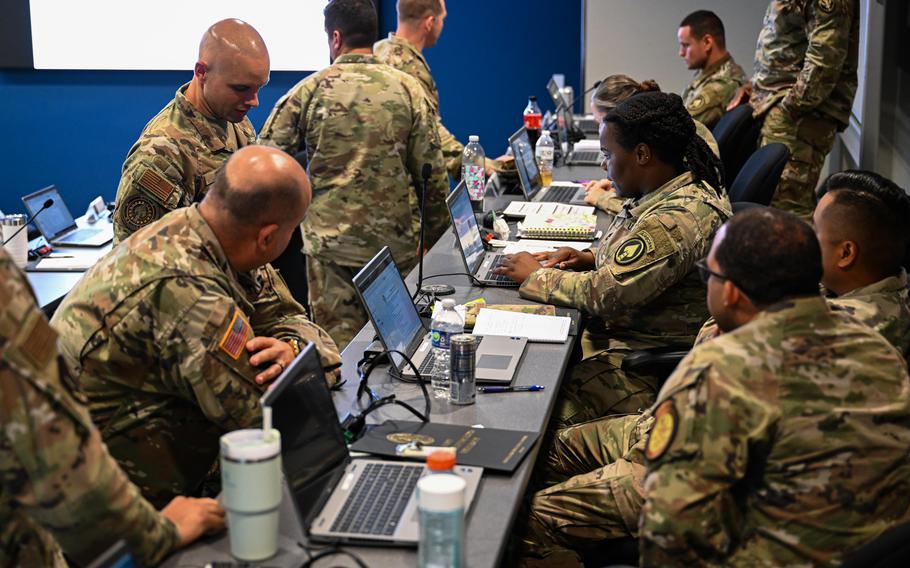
Service members with U.S. Special Operations Command and U.S. Central Command use artificial intelligence to accomplish a practical exercise for an Enhancing Leadership Through Logic, Communication and AI class during Joint Special Operation’s first iteration of the GATEWAY course at JSOU, MacDill Air Force Base, Florida, June 24, 2025. (Marleah Miller/U.S. Air Force)
For users, quality control has become a tainted phrase after Boeing’s safety oversights and Tesla’s seemingly endless recalls. For industry players, it’s a major undertaking that can be as daunting as it is vital. Exponentially complex tech such as autonomous drones and systems, quantum technology, hypersonic weapons, artificial intelligence, sophisticated software and next-level robotics has rendered testing in the defense sector a new beast, and old measures don’t seem to measure up.
Testing advancements like AI and blockchain claim to deliver a much-needed upgrade. For new tools to deliver the benefits they promise, they need to be studied, understood and implemented to ensure safety amid complex assets, and all players, from producers to end users, need to be educated on how they function. But are the tangible benefits for the industry worth all the trouble?
Traditional methods aren’t cutting it
Typical testing measures, such as code reviews and sample inspections, have long served the industry and are the comfortable status quo we all know. But today’s highly complex defense tech demands more, and these traditional methods struggle to keep up. Can new methods answer these shortcomings?
Following its widespread success in other industries, it’s no surprise that AI is at the forefront of QC’s newest tools. It can be harnessed in many different stages of the defense production cycle: AI-powered robotics for precision inspection, AI-enhanced ultrasonic testing to flag minute defects, machine learning for predictive maintenance, AI-enhanced manufacturing plans to minimize mistakes and more.
Emerging tech also ventures outside the AI-powered physical world; virtual testing is a core element of cutting-edge QC. Digital twins, virtual replicas of real-world assets, can predict failures more accurately than traditional simulation testing ever could. But before testing can begin, all the production elements need to come together, which is where supply chain tech comes in.
Quality control in the supply chain, an area fraught with complexity, regulations and vulnerabilities, has long been a pain point. Many QC issues reside here in the form of counterfeit parts, malware, and more. Blockchain is an answer to unreliable supply chains. Assets can be securely tracked from production to deployment. Due to blockchain’s tamper-proof documentation, non-compliant or counterfeit parts cannot enter the supply chain.
These and many other tools, such as XR for inspections and training, and Internet of Things integration in production, revolutionize quality control capabilities. Mindfully implemented, these techniques can elevate the defense industry’s potential.
So what’s the catch?
Shiny innovations may be exciting, but there are roadblocks that may make some hesitant to adopt. One major hurdle is cost. Implementation across different stages can be costly, requiring different tools, new equipment, and even specially-trained employees. This may be a blip on the radar for larger players, but smaller companies feel this impact more dearly. Luckily, open-source and reasonably priced tech can help companies implement on a small scale. Top-tier tech is a great goal, but basic programs can also offer major benefits.
In the rapidly changing defense industry, tech often becomes obsolete in the blink of an eye. Holding off for the next big thing can be a tempting strategy, but the evidence we’ve seen so far suggests that AI is here to stay, and early movers have enjoyed major benefits. Some wait to gather the proper resources before implementing, but new methods don’t need to be integrated all at once. Starting with a small — and inexpensive — tool can be a reasonable start.
What if the old methods are still working? Not all sectors have adopted new tech. In some areas, new methods can be pushed off without many repercussions. But don’t forget that early adopters have the upper hand; those comfortable and fluent in new tech will find future adoption a breeze.
Education requires ongoing efforts
Quality control doesn’t end once the production process is complete — it must remain an ongoing focus of every stakeholder. The same AI programs that help detect errors should also be available to end users to give them a better understanding of the tech-integrated products they rely on and the risks they may carry. Despite rock-solid QC, user error or other factors can cause issues, and users equipped with cutting-edge knowledge are better equipped to find solutions. This requires more training and resources, but teams that know their assets and the process behind them better are more prepared to adapt in this high-tension industry.
This can be a negative factor for those who want to implement in a “one-and-done” fashion. It’s important to be clear that these new methods require constant upkeep and education. The benefits are strong, but they require commitment that may not be feasible for all. But education is what safeguards our values as AI takes over, and will pay back in dividends for those willing to stay proactive.
The backbone of a high-stakes industry
Making major changes can be a headache and requires diligence and careful thought. But old methods are losing traction, and for many, the pain will be worth the prize. New tools need to be pushed to the top of the priority list, and all parties must be involved to ensure an overarching integration of next-gen knowledge. Defense tech will only get hotter, and quality assurance needs to keep up, or it will hold the whole industry back.
Avigdor Brachya is the senior vice president of the Defense & Public Sector Division at the AI-powered quality engineering company Qualitest. With over 20 years in the software industry, he has successfully led numerous cross-functional groups and large-scale, complex projects across the defense, public and BFSI sectors.